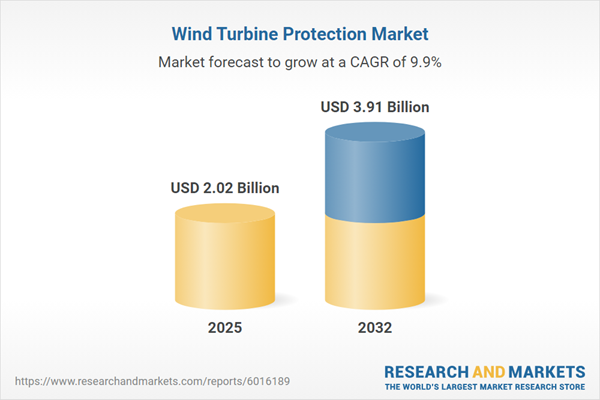Speak directly to the analyst to clarify any post sales queries you may have.
The wind turbine protection market is undergoing pivotal changes as asset owners, OEMs, and service providers confront rising operational demands, climate challenges, and evolving digital threats. The need for advanced, integrated solutions is intensifying as fleets expand across diverse global environments.
Market Snapshot: Wind Turbine Protection Market Growth and Trends
The wind turbine protection market grew from USD 1.84 billion in 2024 to USD 2.02 billion in 2025. It is projected to advance at a compound annual growth rate (CAGR) of 9.86%, reaching USD 3.91 billion by 2032.
Comprehensive Scope & Segmentation of the Wind Turbine Protection Market
- Protection Type: Cybersecurity, Fire Detection, Ice Detection, Lightning Protection, Vibration Monitoring
- Cybersecurity: Endpoint Security, Network Security
- Fire Detection: Smoke Detectors, Thermal Cameras
- Ice Detection: Optical Sensors, Ultrasonic Sensors
- Lightning Protection: Grounding Systems, Surge Arrestors
- Vibration Monitoring: Accelerometers, Velocity Sensors
- Service Type: Hardware, Services, Software
- Hardware: Control Units, Sensor Modules
- Services: Consulting, Installation, Maintenance
- Software: Analytics Platforms, Monitoring Software
- End Use: Offshore (Fixed Platform, Floating Platform), Onshore (Flat Terrain, Mountainous Terrain)
- Turbine Type: Horizontal Axis (Downwind, Upwind), Vertical Axis (Darrieus, Savonius)
- Capacity Range: 1.5-3MW, Greater Than 3MW (3-5MW, Greater Than 5MW), Less Than 1.5MW
- Installation Type: New Installation (Post Commissioning, Pre Commissioning), Retrofit (Ad Hoc Repairs, Scheduled Maintenance)
- Voltage Class: High Voltage, Medium Voltage, Low Voltage
- Regional Coverage: Americas, Europe Middle East & Africa, Asia-Pacific, including country-level insights for North America, Latin America, Europe, Middle East, Africa, and Asia-Pacific regions such as China, India, Japan, Australia, and more
- Company Coverage: Akzo Nobel N.V., The Sherwin-Williams Company, PPG Industries Inc., Hempel A/S, Jotun A/S, Axalta Coating Systems Ltd., BASF SE, RPM International Inc., Nippon Paint Holdings Co., Ltd., Kansai Paint Co., Ltd.
Key Takeaways: Strategic Insights for Wind Turbine Protection Stakeholders
- Integrated digital innovations such as predictive analytics, sensor arrays, and digital twins are shifting the industry focus from reactive to predictive asset management, reducing outage risks and optimizing maintenance cycles.
- The interplay of advanced materials like carbon fiber composites and corrosion-resistant alloys directly supports turbine longevity in harsh onshore and offshore conditions.
- Rising environmental challenges, including extreme temperatures and volatile weather events, are accelerating the need for adaptive and modular protection solutions tailored for floating and fixed installations.
- Policy shifts emphasizing clean energy growth and local content requirements are prompting increased regional manufacturing, supply chain localization, and strategic diversification among OEMs and suppliers.
- Collaborative partnerships and targeted investments in niche innovation areas such as self-healing materials, machine learning-driven anomaly detection, and blockchain for supply chains are redefining competition and value delivery.
- Flexible protection architectures enable tailored asset safeguarding according to varied turbine types, voltage classes, and operational environments.
Tariff Impact on Supply Chains and Cost Structures
- Recent United States tariff measures on imported wind turbine components have led to increased procurement costs and a strategic pivot toward nearshoring, domestic manufacturing, and alternative sourcing strategies.
- OEMs and operators are leveraging component standardization, modular design, and regional partnerships to offset import duties and supply chain disruptions, fostering innovation in localized production and design flexibility.
- These dynamics present both short-term cost pressures and long-term opportunities for greater resilience and market adaptation in the wake of changing trade policies.
Methodology & Data Sources
This analysis is built on rigorous primary and secondary research, including executive interviews, proprietary quantitative data, and detailed reviews of technical literature and regulatory frameworks. The methodology integrates scenario analysis and cross-validation to deliver robust, actionable market intelligence.
Why This Report Matters
- Enables senior leaders to anticipate strategic risks and identify high-growth segments in wind turbine protection.
- Supports confident investment and operational decisions across procurement, R&D, and supply chain management.
- Provides actionable intelligence to shape partnerships, comply with evolving regulation, and strengthen asset resiliency in a dynamic market landscape.
Conclusion
Comprehensive wind turbine protection is critical to maximizing asset reliability and securing long-term value across changing regulatory and environmental landscapes. Data-driven strategies, adaptive solutions, and collaborative innovation are shaping the future of this dynamic market.
Additional Product Information:
- Purchase of this report includes 1 year online access with quarterly updates.
- This report can be updated on request. Please contact our Customer Experience team using the Ask a Question widget on our website.
Table of Contents
3. Executive Summary
4. Market Overview
7. Cumulative Impact of Artificial Intelligence 2025
Companies Mentioned
The companies profiled in this Wind Turbine Protection market report include:- Akzo Nobel N.V.
- The Sherwin-Williams Company
- PPG Industries, Inc.
- Hempel A/S
- Jotun A/S
- Axalta Coating Systems Ltd.
- BASF SE
- RPM International Inc.
- Nippon Paint Holdings Co., Ltd.
- Kansai Paint Co., Ltd.
Table Information
| Report Attribute | Details |
|---|---|
| No. of Pages | 185 |
| Published | November 2025 |
| Forecast Period | 2025 - 2032 |
| Estimated Market Value ( USD | $ 2.02 Billion |
| Forecasted Market Value ( USD | $ 3.91 Billion |
| Compound Annual Growth Rate | 9.8% |
| Regions Covered | Global |
| No. of Companies Mentioned | 11 |









